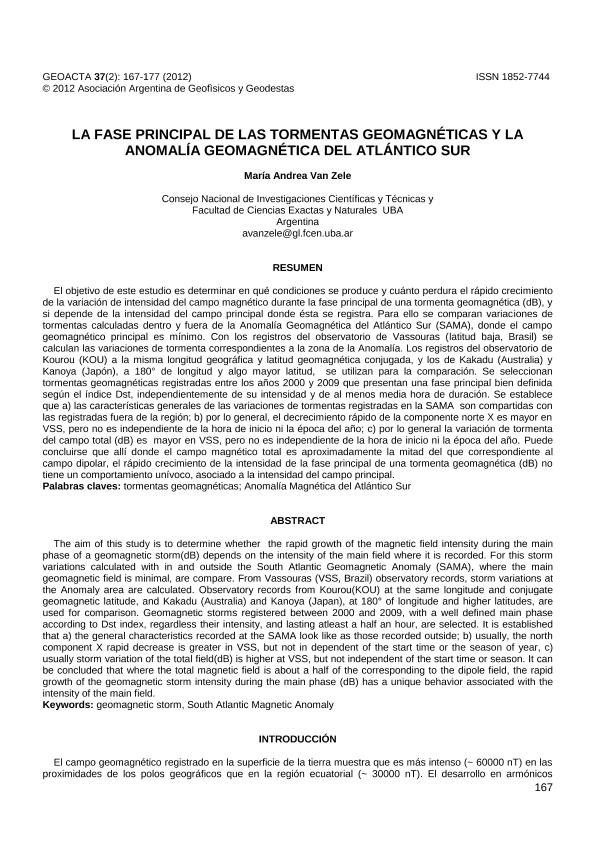Artículo
El objetivo de este estudio es determinar en qué condiciones se produce y cuánto perdura el rápido crecimiento de la variación de intensidad del campo magnético durante la fase principal de una tormenta geomagnética (dB), y si depende de la intensidad del campo principal donde ésta se registra. Para ello se comparan variaciones de tormentas calculadas dentro y fuera de la Anomalía Geomagnética del Atlántico Sur (SAMA), donde el campo geomagnético principal es mínimo. Con los registros del observatorio de Vassouras (latitud baja, Brasil) se calculan las variaciones de tormenta correspondientes a la zona de la Anomalía. Los registros del observatorio de Kourou (KOU) a la misma longitud geográfica y latitud geomagnética conjugada, y los de Kakadu (Australia) y Kanoya (Japón), a 180° de longitud y algo mayor latitud, se utilizan para la comparación. Se seleccionan tormentas geomagnéticas registradas entre los años 2000 y 2009 que presentan una fase principal bien definida según el índice Dst, independientemente de su intensidad y de al menos media hora de duración. Se establece que a) las características generales de las variaciones de tormentas registradas en la SAMA son compartidas con las registradas fuera de la región; b) por lo general, el decrecimiento rápido de la componente norte X es mayor en VSS, pero no es independiente de la hora de inicio ni la época del año; c) por lo general la variación de tormenta del campo total (dB) es mayor en VSS, pero no es independiente de la hora de inicio ni la época del año. Puede concluirse que allí donde el campo magnético total es aproximadamente la mitad del que correspondiente al campo dipolar, el rápido crecimiento de la intensidad de la fase principal de una tormenta geomagnética (dB) no tiene un comportamiento unívoco, asociado a la intensidad del campo principal. The aim of this study is to determine whether the rapid growth of the magnetic field intensity during the main phase of a geomagnetic storm(dB) depends on the intensity of the main field where it is recorded. For this storm variations calculated with in and outside the South Atlantic Geomagnetic Anomaly (SAMA), where the main geomagnetic field is minimal, are compare. From Vassouras (VSS, Brazil) observatory records, storm variations at the Anomaly area are calculated. Observatory records from Kourou(KOU) at the same longitude and conjugate geomagnetic latitude, and Kakadu (Australia) and Kanoya (Japan), at 180° of longitude and higher latitudes, are used for comparison. Geomagnetic storms registered between 2000 and 2009, with a well defined main phase according to Dst index, regardless their intensity, and lasting atleast a half an hour, are selected. It is established that a) the general characteristics recorded at the SAMA look like as those recorded outside; b) usually, the north component X rapid decrease is greater in VSS, but not in dependent of the start time or the season of year, c) usually storm variation of the total field(dB) is higher at VSS, but not independent of the start time or season. It can be concluded that where the total magnetic field is about a half of the corresponding to the dipole field, the rapid growth of the geomagnetic storm intensity during the main phase (dB) has a unique behavior associated with the intensity of the main field.
La fase principal de las tormentas geomagnéticas y la anomalía geomagnética del Atlántico Sur
Fecha de publicación:
12/2012
Editorial:
Asociación Argentina de Geofísicos y Geodestas
Revista:
GeoActa
ISSN:
1852-7744
Idioma:
Español
Tipo de recurso:
Artículo publicado
Clasificación temática:
Resumen
Palabras clave:
Tormentas Geomagnéticas
,
Anomalía Magnética del Atlántico Sur
Archivos asociados
Licencia
Identificadores
Colecciones
Articulos(IGEBA)
Articulos de INSTITUTO DE GEOCIENCIAS BASICAS, APLICADAS Y AMBIENTALES DE BS. AS
Articulos de INSTITUTO DE GEOCIENCIAS BASICAS, APLICADAS Y AMBIENTALES DE BS. AS
Citación
Van Zele, Maria Andrea; La fase principal de las tormentas geomagnéticas y la anomalía geomagnética del Atlántico Sur
; Asociación Argentina de Geofísicos y Geodestas; GeoActa; 37; 2; 12-2012; 167-177
Compartir




